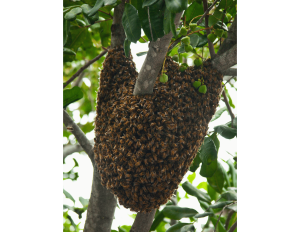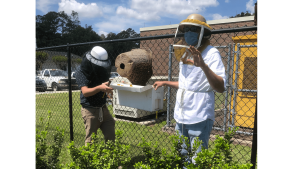The warm Florida spring is well upon us and honey bee colonies have certainly taken notice. The UF/IFAS Clay County Extension Office has received numerous calls concerning honey bees forming dense masses of bees. This is called a swarm. Bee swarms can be an intimidating site, especially when spotted on your house or even your car windshield!

Why do honey bees swarm?
Honey bees live in large colonies, which can contain anywhere from 10,000 to 150,000 bees. When flowers bloom in spring, honey bee colonies are full of resources including pollen, nectar, and honey. The bees have plenty of supplies to support a growing colony, but there is only so much space in the hive. When the colony gets too big, the queen will take 50 to 60% of the worker bees in the hive with her to start another colony in a new hive. The remaining workers are left with plenty of space to grow and develop the original colony.
The bees and their queen set off in a swarm, usually landing together on a branch, fence, wall, or other surface in a large mass of bees. The new colony waits here while “scout” bees search the area for a suitable new home. Once they find the perfect spot, they’ll return to the swarm and lead them to their new home to start hive construction. The final result is two honey bee colonies from the original one. Swarming is how honey bees reproduce on the colony level.
Are honey bee swarms dangerous?
It’s no secret that bees can sting, and it is always wise to use caution around them and let them be when possible. However, it is unfortunate that the fact that bees sting has made many fearful of this very interesting insect. When swarming, honey bees are relatively docile. A swarm of bees does not have a hive, resources, or brood (honey bee eggs and larvae) to protect, and therefore are not very aggressive. Always respect the colony’s space to avoid stings and take bee allergies very seriously. Still, there’s no rush to call pest control when you see a swarm of honey bees.

What should I do when I find a swarm?
Luckily, a honey bee swarm is a short term incident. The swarm of honey bees will likely move into their new hive within 24 hours. Thus, leaving the swarm alone and waiting for them to move on is an option. However, a honey bee swarm also has the opportunity to be a valuable addition to a beekeeper’s apiary. If possible, contact a local beekeeper or beekeeper’s association to see if they are able to come collect the swarm. A simple online search will bring you right to local beekeeper’s associations who can get in touch with nearby beekeepers. It’s possible that the swarm came from a neighbor beekeeper who might want to get his bees back! You can also contact your local UF/IFAS Extension office for additional assistance and information.

 1
1
